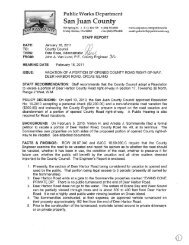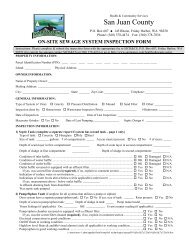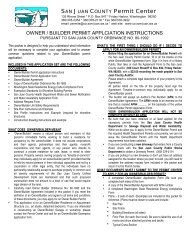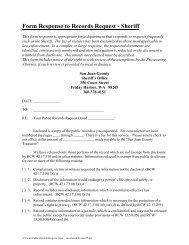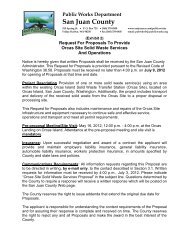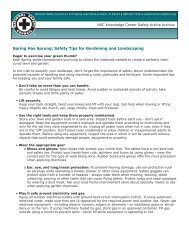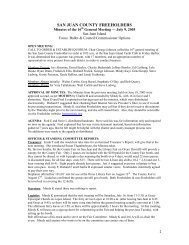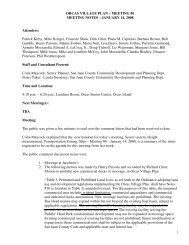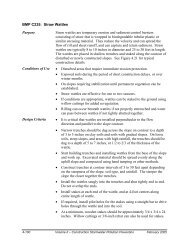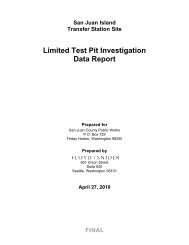Ordinance No._____- 2012 AN ORDINANCE ... - San Juan County
Ordinance No._____- 2012 AN ORDINANCE ... - San Juan County
Ordinance No._____- 2012 AN ORDINANCE ... - San Juan County
You also want an ePaper? Increase the reach of your titles
YUMPU automatically turns print PDFs into web optimized ePapers that Google loves.
Page 37 of 56<br />
Ord. ____-<strong>2012</strong><br />
Step 5. Averaging of Tree Protection Zone. Averaging of the tree protection zoneTree Protection Zone<br />
allows reduction of the zone in specified locations on the property proposed for development, vegetation<br />
removal or other modification, in conjunction with increases of the zone in other areas, so that the total<br />
area of the zone is unchanged. Averaging of the required tree protection zoneTree Protection Zone will<br />
be allowed only if the applicant demonstrates that all of the following criteria are met:<br />
a. Averaging is necessary to accomplish the purposes of the proposal, and no reasonable alternative<br />
is available;<br />
b. Averaging width will not adversely affect the functions and values of the FWHCA;<br />
c. The total area contained within the tree protection zoneTree Protection Zone after averaging is no<br />
less than that contained within the standard zone prior to averaging;<br />
d. Only area within 200 feet of the OHWM or bank full width will be counted toward the required<br />
area of the tree protection zoneTree Protection Zone; and<br />
e. In no instance shall the tree protection zoneTree Protection Zone be reduced to less than the water<br />
quality- sensitivity buffer or 70 feet, whichever is greater;<br />
Step 6. Determine the greater of the three components. Compare the size of the tree protection<br />
zoneTree Protection Zone, water quality-sensitivity buffer, and if required, the coastal geologic buffer.<br />
The area that must be protected is the greater of the three components. (<strong>No</strong>te: For larger parcels, the area<br />
that must be protected may be larger in one area than in others. For example, if a portion of the lot has<br />
trees and a portion does not, the tree protection zoneTree Protection Zone only applies to the area with<br />
trees). Also see SJCC 18.50.330.<br />
Step 7. Buffers, Tree Protection Zones, and Existing Development. Where structures or impervious<br />
surfacesareas, legally established prior to the effective date of these regulations, encroach into a required<br />
buffer or tree protection zoneTree Protection Zone, the buffer or zone shall be modified to exclude the<br />
footprint of those structures and impervious areas. Buffers and tree protection zoneTree Protection Zones<br />
shall not extend across public roads. For private roads, buffers and tree protection zoneTree Protection<br />
Zones shall not extend across the road when the road design, flow of runoff, quantity of traffic, and/or<br />
gap in tree canopy result in an area that does not support functions and values of the FWHCA to be<br />
protected, as determined by a qualified professional. Structures, roads and impervious areas may be<br />
modified, replaced, relocated, or expanded within the development area existing on the effective date of<br />
these regulations, in conformance with the procedures and requirements of SJCC 18.30.110.G.<br />
2. Structures, Uses and Activities Allowed and Prohibited in Streams, Marine Waters, Lakes, and<br />
Ponds Designated as FWHCAs, and their Buffers and Tree Protection Zones.<br />
In order to protect their functions and values, development activities, removal of vegetation and other<br />
modifications are limited or prohibited within aquatic FWHCAs and their buffers and tree protection<br />
zoneTree Protection Zones.<br />
Tree protection zones are divided into two sections: Zone 1 consists of the first 35 feet adjacent to the<br />
water, beginning at the OHWM, or for streams, the bank full width. Zone 2 is the remainder of the tree<br />
protection zoneTree Protection Zone. Within Zone 1 all trees must be retained. Within Zone 2<br />
construction of one primary structure, and/or limited tree removal to allow for a filtered view from the<br />
primary structure is allowed in conformance with all of the following:<br />
a. The structure, impervious areas, and areas where soils will be compacted or where the organic soil<br />
horizon will be removed, are located landward of the water quality- sensitivity buffer;<br />
b. Appropriate BMPs are used to minimize erosion, sedimentation, and soil disturbance;<br />
c. <strong>No</strong> more than 40% of the volume of trees over 6 inches dbh are removed in any 10 year period;<br />
d. Stocking levels for trees ≥ six inches dbh will be at least the following:<br />
i. Softwood stands (>66% softwood volume): 80. basal area per acre (approximately equivalent to<br />
Comment [SH4]: Consider removing the<br />
allowance for a structure in Zone 2 of the Tree<br />
Protection Zone because it is not well supported by<br />
the BAS.<br />
N:\L<strong>AN</strong>D USE\LONG R<strong>AN</strong>GE PROJECTS\PCODES-11-0004 CAO FWHCAs\Docs from PC and CC\FWHCAOrdCC_<strong>2012</strong>-10-26.doc



